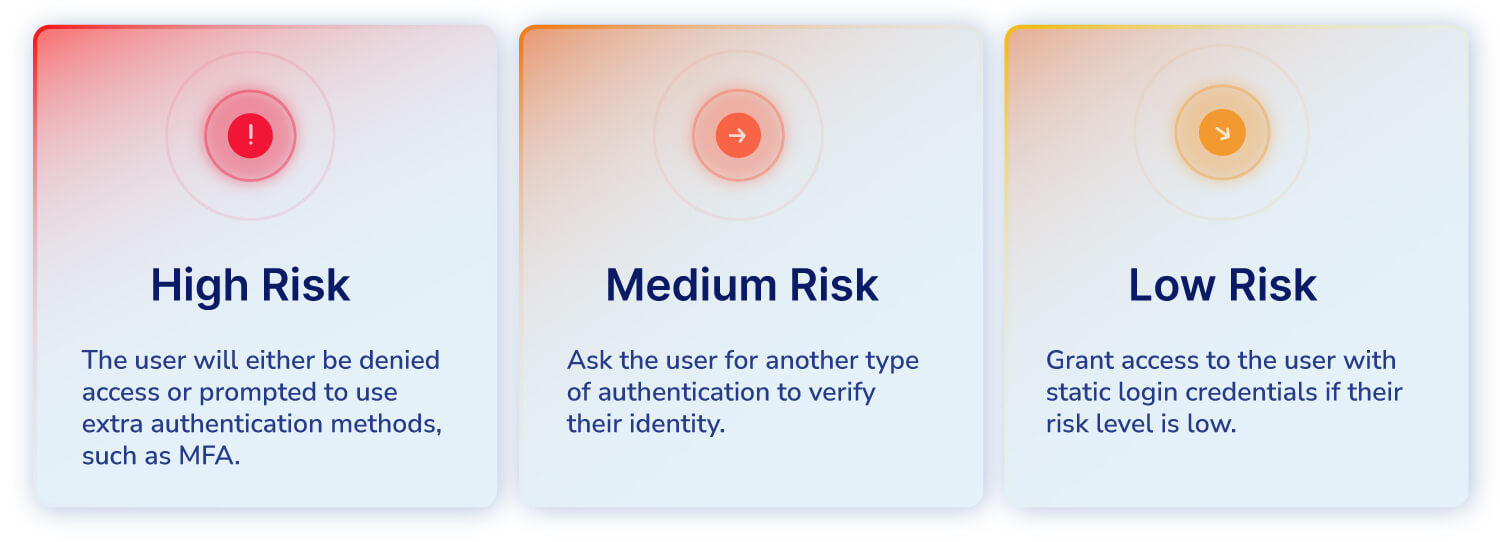Contents:
Risk-Based Authentication (RBA) is a security mechanism that checks the profile of the agent asking for access to assess the potential risk associated with that transaction.
RBA is also known as context-based authentication or adaptive authentication. Some of the profile data that it takes into account are the IP address, device, behavior, time of access, history, etc.
How Does It Work?
The fundamental idea behind risk-based authentication is to adapt the security measures for an authentication attempt according to the potential risk it presents.
For instance, a low-risk authentication request might need just a username and a password. A high-risk authentication request (such as an attempted login from a device located in a foreign country or using an unidentified browser) might call for extra security measures like multi-factor authentication.
The Importance of Risk-Based Authentication
Given the surge in cyberattacks and the sophisticated techniques employed by hackers to get into systems, confirming someone’s identity should require more than just their username and password. When allowing a user access to private data, organizations must take into account multiple factors.
By implementing RBA, companies can lower the risk of unauthorized access to their systems and sensitive information while eliminating the inconvenience to legitimate users. This strategy can also assist businesses in meeting regulatory requirements for robust authentication procedures without overburdening users.
Risk-Based Authentication Factors
Risk-Based Authentication (RBA) looks at various unique factors to establish the risk level of a certain authentication request. These factors support the system in determining whether to provide access, require further authentication, or completely deny the attempt to login. The following are the main aspects that RBA takes into account:
1. Contextual Information
- User Location: Is the user logging in from a known or unknown place?
- IP Address: Is the IP address linked to known fraudulent activities or detected in an unusual location?
- Device Type: Is the used device recognized or unfamiliar to the system?
- Browser and Version: Certain browser versions might be more susceptible to vulnerabilities.
- Time of Access: Is the user trying to access at an unusual time, inconsistent with their regular patterns?
2. Behavioral Biometrics
- Keystroke Dynamics: How a user types can be distinctive (e.g., speed, rhythm).
- Mouse Movement Patterns: The way a user moves the mouse can also be unique.
- Touchscreen Interactions: For mobile devices, touch behavior like swipe speed and pressure can be indicators.
3. Device Profiling
Comprehensive device information, including operating system, screen resolution, and existing plugins, could be helpful in determining whether the device is regularly used or a possible threat.
4. Historical User Behavior
Previous activity, typical login times, frequently used information, and other patterns can be used to establish a benchmark for expected behavior.
5. Transaction Behavior
For systems that manage transactions, the type, amount, or frequency of a transaction can be monitored for anomalies.
6. Connection Attributes
It is possible to take into account factors like connection type (such as Wi-Fi, VPN, or mobile data), internet service provider, or connection speed.
7. Session Information
The duration of a user’s session, the resources they access, and other session habits may be signs of legitimate or suspicious activity.
8. Geolocation and Geofencing
Establishing “safe zones” from where access is usually permitted and flagging requests from outside these zones.
9. Challenge Response
Interactions with challenge mechanisms, such as CAPTCHAs or security questions, and the user’s accuracy and response time.
These factors are analyzed in real-time, and a corresponding risk score is assigned to the authentication request based on their combination. The system then decides on the best course of action, ensuring a balance between user convenience and security.
This is how risk scores are calculated:

As shown, users might be asked for a second authentication method depending on the perceived risk.
On the other hand, if the assessed risk is minimal, they can enjoy a seamless experience. For instance, if a user is on the company’s device and network during regular business hours, they might not have to re-input their credentials even after their session times out.
Users frequently have no idea that risk-based authentication is being used. Step-up authentication is only rarely necessary because the majority of transactions don’t qualify as high-risk. One of the greatest advantages of risk-based authentication is that it provides a smooth user experience while providing additional protection to an organization’s infrastructure.
Risk-Based Authentication (RBA) Benefits
An RBA approach has multiple significant advantages for organizations and users:
Increased Security
Risk-based authentication offers a more effective method of authentication by assessing the risk level involved with each login attempt and adjusting the level of authentication needed appropriately. This helps to accurately detect and block unauthorized access to systems and confidential information.
Less Friction & Improved User Experience
Users may find traditional authentication methods bothersome, especially if they have to go through several authentication steps. By requesting these extra steps only when necessary, based on the evaluated risk, RBA provides genuine users with a seamless experience. This way, users do not have to deal with additional security processes during low-risk activities, which can boost user satisfaction and productivity.
Adaptive Protection
RBA offers dynamic security by constantly adapting to new threats, user behaviors, and contextual factors.
Data-Driven Decision Making
RBA systems provide organizations with insights regarding user behavior and potential security issues, helping them to make educated security decisions.
Flexibility
The risk levels and related actions can be tailored by companies in order to meet their unique security requirements.
Increased Trust
When strong security measures are implemented, both users and stakeholders will be confident when it comes to the system’s protection.
Efficient Resource Utilization
Strong authentication does not need to be used consistently; instead, resources can be focused on high-risk activities to provide efficient security management.
Integration with Other Systems
To offer complete protection, Risk-Based Authentication systems can be integrated with other security technologies, such as threat intelligence platforms.
Cost-Effectiveness
Risk-based authentication can be less expensive than traditional authentication approaches, especially when combined with cloud-based authentication services. This is especially advantageous for smaller businesses that may lack the means of implementing more complex authentication measures. Also, by minimizing the risk of security breaches, organizations can avoid potential financial losses and expenses associated with damage control.
Fraud Prevention
RBA technology can help in the prevention of online fraud and unauthorized access attempts via notifications and multiple verification steps.
What Do Specialists Say about RBA?
According to Forrester Research, Risk-Based Authentication is particularly vital for financial services companies since online and mobile transactions are increasingly popular.
The research company claims that a market differentiator is the ability to minimize consumer discomfort and hassle while maintaining security. Forrester adds that an anti-fraud solution must be able to assess as much user, device, and transaction information as possible across digital channels in order to deliver the most accurate risk score.
What to Look for in an RBA System?
When considering a Risk-Based Authentication (RBA) solution, it’s important to prioritize comprehensive contextual analysis that looks at factors such as device type, location, and user behaviors. Integration with Multi-Factor Authentication and real-time threat intelligence feeds is critical for increased protection.
Advanced RBA solutions should leverage machine learning to continuously adapt to user behaviours and new threats. It is essential to strike a balance between strong security measures and a smooth user experience. Moreover, it is preferable to choose a system that provides real-time analysis, is scalable, readily integrates with current IT infrastructures, and complies with privacy regulations. Finally, assess the solution’s image in the industry, its price, and the support and updates it offers.
Conclusion
When it comes to cybersecurity, we are frequently torn between the importance of robust security and the desire for simplicity. With approaches like Risk-Based Authentication, we can have both.
By dynamically changing authentication measures based on real-time risk assessments, it finds a balance between rigorous security and user convenience. As cyber threats become more complex, adopting RBA is no longer only an option but a need for organizations seeking to protect their digital assets.
Risk-Based Authentication (RBA) FAQs
How does RBA differ from traditional authentication methods?
Unlike static methods like passwords, RBA evaluates various contextual and behavioral factors to determine the level of risk and then adjusts the authentication process accordingly.
What factors does RBA consider?
RBA can assess user location, device type, time of access, behavioral patterns, transaction behaviors, IP address, and more to determine risk.
Why is RBA important for businesses?
RBA enhances security by preventing unauthorized access while also improving the user experience by reducing friction during low-risk access attempts.
Does RBA replace passwords or Multi-Factor Authentication (MFA)?
No, RBA often works in conjunction with passwords and MFA. It determines when and if additional authentication layers, like MFA, are necessary.
What’s the cost implication of implementing RBA?
Costs vary depending on the solution provider, the scale of implementation, and other factors. However, potential savings from preventing security breaches often justify the investment.
How Can Heimdal® Help?
In the fight against unauthorized access, Heimdal® comes with a powerful solution: Heimdal Privileged Access Management. This revolutionary tool allows administrators to manage user permissions easily. Your system admins will be able to approve or deny user requests from anywhere or set up an automated flow from the centralized dashboard. Furthermore, Heimdal Privileged Access Management is the only PAM solution on the market that automatically de-escalates on threat detection. Combine it also with our Application Control module, which lets you perform application execution approval or denial or live session customization to further ensure business safety.

Heimdal® Privileged Access Management
- Automate the elevation of admin rights on request;
- Approve or reject escalations with one click;
- Provide a full audit trail into user behavior;
- Automatically de-escalate on infection;
If you enjoyed this article, follow us on LinkedIn, Twitter, Facebook, or YouTube to keep up to date with everything we post!










 Network Security
Network Security
 Vulnerability Management
Vulnerability Management
 Privileged Access Management
Privileged Access Management  Endpoint Security
Endpoint Security
 Threat Hunting
Threat Hunting
 Unified Endpoint Management
Unified Endpoint Management
 Email & Collaboration Security
Email & Collaboration Security








